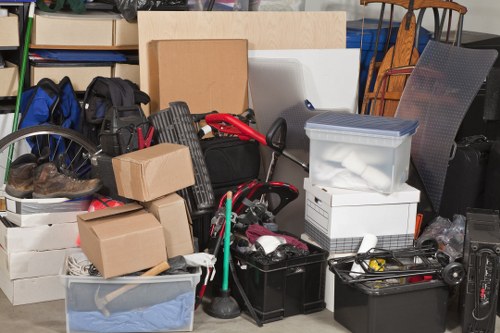Garbage Collection in Furniture Disposal: A Comprehensive Guide

Furniture disposal is an essential aspect of maintaining a clean and organized living or working space. As items age or become obsolete, finding environmentally responsible ways to dispose of them becomes increasingly important. This comprehensive guide delves into the intricacies of garbage collection in furniture disposal, highlighting best practices, methods, and the environmental impact associated with improper disposal.
Understanding the various methods and services available for furniture disposal can help individuals and businesses make informed decisions that benefit both the environment and their own well-being. From professional garbage collection services to recycling and donation options, this guide covers the spectrum of furniture waste management strategies.
Proper disposal ensures that valuable materials are reclaimed, reducing the need for new resources and minimizing the volume of waste sent to landfills. It also plays a crucial role in preventing environmental degradation and promoting sustainability in our communities.

Understanding Furniture Disposal
Furniture disposal encompasses the processes and methods used to eliminate unwanted or unusable furniture items. This can include everything from outdated office desks and chairs to worn-out sofas and beds. Effective furniture disposal not only clears space but also impacts the environment and public health.
There are various reasons why furniture disposal is necessary. It can be due to the end of a product’s lifecycle, damage beyond repair, or simply the desire to update aesthetics or functionality within a space. Regardless of the reason, choosing the right disposal method is crucial for sustainable waste management.
**Furniture waste management** involves a combination of strategies to handle discarded furniture responsibly. This includes recycling, donating, repurposing, or disposing of items in landfills. Each method has its own set of benefits and considerations, making it important to evaluate the best approach based on specific circumstances.

What Constitutes Furniture Waste
Furniture waste can include a wide range of items such as beds, tables, chairs, sofas, cabinets, and office furniture like desks and filing cabinets. These items are typically made from materials like wood, metal, fabric, and plastics, which can be recycled or repurposed if handled correctly.
Not all furniture is created equal when it comes to disposal. Items made from sustainable or recyclable materials are easier to manage environmentally. Conversely, furniture containing hazardous materials or complex compositions may require specialized disposal methods to prevent environmental harm.
Additionally, the condition of the furniture plays a role in determining the appropriate disposal method. Items that are still functional can often be donated or sold, while those that are damaged beyond repair might need to be recycled or disposed of through professional garbage collection services.
Importance of Proper Furniture Disposal
Proper furniture disposal is critical for several reasons. It helps reduce the amount of waste sent to landfills, conserves natural resources by promoting recycling and reuse, and prevents environmental pollution from improperly disposed materials.
Moreover, responsible disposal practices contribute to community health and cleanliness. Accumulated waste can become a breeding ground for pests and can negatively impact the aesthetic appeal of neighborhoods and commercial areas.
By adopting sustainable furniture disposal methods, individuals and organizations can play a part in mitigating climate change and promoting a healthier environment for future generations.

The Role of Garbage Collection in Furniture Disposal
Garbage collection services play a pivotal role in the furniture disposal process. These services offer structured and reliable methods to handle large and bulky items that are otherwise difficult to discard.
Professional garbage collection ensures that furniture is disposed of in compliance with local regulations and environmental standards. This reduces the risk of illegal dumping and promotes accountability in waste management practices.
These services often provide options for recycling and repurposing, ensuring that materials from discarded furniture are recovered and reused effectively. By partnering with certified garbage collection providers, individuals and businesses can enhance their sustainability efforts.
How Garbage Collection Services Handle Furniture
Garbage collection services employ specialized equipment and trained personnel to handle the pickup, transport, and disposal of furniture items. The process typically involves:
- Scheduling Pickup: Clients arrange for a convenient time for their furniture to be collected.
- Assessment: The collection team assesses the items to determine the best disposal method.
- Transportation: Furniture is transported to recycling centers, donation facilities, or landfills based on its condition and materials.
- Processing: At disposal sites, items are sorted for recycling, repurposing, or responsible landfill disposal.
This structured approach ensures that furniture disposal is handled efficiently and sustainably.
Environmental Impact of Professional Disposal
Professional garbage collection significantly mitigates the environmental impact of furniture disposal. By ensuring that materials are sorted and recycled appropriately, these services reduce the demand for raw materials and lower greenhouse gas emissions associated with manufacturing new products.
Additionally, proper disposal prevents the contamination of soil and water sources from hazardous materials that might be present in some furniture items. This safeguards ecosystems and promotes public health.
Ultimately, the role of garbage collection in furniture disposal is integral to building a more sustainable and environmentally conscious society.

Methods of Furniture Disposal
There are several methods available for furniture disposal, each with its own advantages and considerations. Understanding these methods can help determine the most suitable approach based on the condition of the furniture and personal or organizational preferences.
Common methods include donation and reuse, recycling, and landfill disposal. Each method contributes differently to sustainability and waste reduction efforts.
Donation and reuse are ideal for furniture that is still in good condition. This approach extends the lifecycle of items, benefits those in need, and reduces waste.
Donation and Reuse
Donating furniture to charitable organizations or second-hand stores is a sustainable choice. It not only provides usable items to others but also reduces the number of items that need to be produced, conserving resources.
Reusing furniture can involve repurposing items for different functions or updating their appearance to fit new settings. This creative approach can breathe new life into old pieces, making them relevant and functional once again.
Moreover, many communities have programs that facilitate the donation process, making it easier for individuals and businesses to contribute to sustainability efforts.
Recycling
Recycling involves breaking down furniture materials for reuse in new products. Materials like wood, metal, and certain plastics can be efficiently recycled, reducing the need for virgin materials.
Recycling not only conserves natural resources but also lowers the overall energy consumption and carbon footprint associated with manufacturing.
Furniture recycling requires specialized facilities that can process different materials effectively. Choosing a reputable recycling service ensures that materials are handled responsibly.
Landfill Disposal
When furniture cannot be donated or recycled, landfill disposal becomes the last resort. This method involves sending items to landfills where they are buried and managed to minimize environmental impact.
However, landfill disposal has significant drawbacks, including the consumption of land resources and the potential release of harmful substances into the environment over time.
Therefore, landfill disposal should only be considered when other sustainable options are unavailable.
Steps to Effective Furniture Waste Management
Effective furniture waste management involves a systematic approach to ensure that disposal is handled responsibly and sustainably. Following these steps can help streamline the process and maximize environmental benefits.
Assessing your furniture for disposal, ***choosing the right disposal method***, and scheduling garbage collection are key stages in this process.
By carefully evaluating each piece of furniture, determining the most suitable disposal method, and coordinating with reliable garbage collection services, individuals and businesses can manage waste efficiently.
Assessing Your Furniture for Disposal
The first step in furniture waste management is assessing the condition and usability of each item. Consider factors such as functionality, structural integrity, and aesthetic appeal.
Items that are still functional and in good condition are prime candidates for donation or resale. Conversely, furniture that is damaged or worn out may require recycling or professional disposal.
Additionally, evaluating the materials used in the furniture can help determine the best recycling methods, ensuring that each component is handled appropriately.
Choosing the Right Disposal Method
Once furniture has been assessed, the next step is selecting the most appropriate disposal method. Consider the following factors:
- Condition of the furniture
- Material composition
- Local recycling and donation options
- Cost and convenience
Selecting the right method ensures that furniture is disposed of responsibly, enhancing sustainability efforts and complying with local regulations.
Scheduling Garbage Collection
Scheduling garbage collection for large or bulky furniture items can simplify the disposal process. Professional services offer convenient pickup times and handle the logistics of transporting furniture to appropriate facilities.
Coordinate with garbage collection providers to arrange for timely pickup, ensuring that disposal aligns with your schedule and disposal needs.
Many services offer online booking and provide estimates, making it easier to plan and execute effective furniture disposal.
Benefits of Professional Garbage Collection for Furniture Disposal
Engaging professional garbage collection services for furniture disposal offers numerous advantages, ranging from convenience to environmental benefits.
These services are designed to handle large items efficiently, ensuring that disposal is managed responsibly and in compliance with regulations.
Here are some key benefits of using professional garbage collection for furniture disposal:
Convenience and Efficiency
Professional garbage collection services streamline the disposal process, saving time and effort. They handle the heavy lifting, transportation, and proper disposal of furniture items, allowing clients to focus on other priorities.
These services often provide flexible scheduling options, ensuring that disposal aligns with the client's availability and needs.
Efficiency is enhanced through organized processes and dedicated teams, minimizing disruptions and ensuring swift disposal.
Cost-Effectiveness
While there is a cost associated with professional garbage collection, it is often outweighed by the convenience and efficiency provided. These services eliminate the need for renting trucks or making multiple trips, saving both time and money.
Additionally, proper disposal can prevent potential fines or penalties associated with illegal dumping, making professional services a financially sound choice.
Many providers also offer competitive pricing and packages tailored to different disposal needs, ensuring affordability.
Compliance with Regulations
Professional garbage collection ensures that furniture disposal complies with local and national regulations. These services are knowledgeable about waste management laws and adhere to them, preventing legal complications for clients.
Compliance includes proper sorting, recycling, and disposal methods that meet environmental standards. This reduces the risk of environmental harm and supports sustainability initiatives.
By using certified garbage collection services, individuals and businesses can ensure that their furniture disposal practices are responsible and lawful.
Tips for Sustainable Furniture Disposal Practices
Adopting sustainable practices in furniture disposal not only benefits the environment but also promotes resource conservation and community well-being. Here are some tips to enhance sustainability in furniture waste management:
Prioritizing Reuse and Donation
Whenever possible, opt to reuse or donate furniture items. This extends the lifecycle of usable items, reduces the demand for new products, and supports those in need.
Research local charities, non-profits, and community organizations that accept furniture donations. Many offer free pickup services, making the process hassle-free.
Reusing furniture creatively can also add unique character to spaces, blending sustainability with design.
Recycling Tips
Recycling is a crucial component of sustainable furniture disposal. To maximize the benefits of recycling, consider the following tips:
- Separate materials: Disassemble furniture to sort different materials like wood, metal, and plastic.
- Clean items: Ensure that recycled materials are clean and free of contaminants to facilitate effective processing.
- Use certified recyclers: Partner with reputable recycling facilities that adhere to environmental standards.
By following these tips, recycling efforts become more effective, contributing to resource conservation and waste reduction.
Minimizing Waste
Minimizing waste involves being mindful of the amount and type of furniture discarded. Consider strategies such as:
- Buying quality items: Invest in durable furniture that lasts longer, reducing the frequency of disposal.
- Maintaining furniture: Regular upkeep can extend the lifespan of items, delaying the need for disposal.
- Planning purchases: Assess needs carefully to avoid overbuying and accumulating unnecessary furniture.
Implementing these strategies can significantly reduce the volume of furniture waste generated, promoting a more sustainable lifestyle.
Common Challenges in Furniture Disposal and How to Overcome Them
Furniture disposal presents several challenges, including handling large items, navigating regulations, and ensuring sustainability. Addressing these challenges requires informed strategies and reliable resources.
By understanding and preparing for these obstacles, individuals and businesses can manage furniture waste more effectively.
Here are some common challenges and solutions:
Large Item Handling
One of the primary challenges in furniture disposal is managing large or bulky items. These items often require special handling, transportation, and disposal methods.
Solution: Utilize professional garbage collection services that specialize in handling large items. These services have the necessary equipment and expertise to manage bulky furniture safely and efficiently.
Additionally, disassembling furniture can make transportation easier and reduce the risk of damage or injury.
Navigating Disposal Regulations
Disposing of furniture involves adhering to various local and national regulations, which can be complex and time-consuming.
Solution: Stay informed about the regulations in your area by consulting local waste management authorities or environmental agencies. Professional garbage collection services are well-versed in these regulations and can ensure compliance, minimizing the risk of legal issues.
Additionally, conducting thorough research before disposal can help identify the proper methods and requirements for different types of furniture.
Ensuring Sustainability
Maintaining sustainable disposal practices is essential but can be challenging without the right information and resources.
Solution: Prioritize recycling, donation, and reuse whenever possible. Partner with organizations that emphasize sustainability and environmental responsibility.
Educate yourself and your community about the benefits of sustainable furniture disposal and encourage practices that support these goals.
Future Trends in Furniture Disposal and Garbage Collection
The landscape of furniture disposal and garbage collection is evolving, driven by technological advancements and an increasing focus on sustainability. Anticipating these trends can help individuals and businesses stay ahead in waste management practices.
Here are some emerging trends shaping the future of furniture disposal:
Advancements in Recycling Technologies
Innovations in recycling technologies are enhancing the efficiency and effectiveness of furniture waste management. Advanced separation techniques and material processing methods enable better recovery of valuable resources.
These technologies reduce the environmental footprint of disposed furniture by maximizing material reuse and minimizing waste.
As recycling technologies continue to evolve, the capacity to handle diverse and complex materials will improve, facilitating more sustainable disposal practices.
Increased Focus on Sustainability
There is a growing emphasis on sustainability in furniture disposal and garbage collection. This focus is driving the development of eco-friendly disposal methods and the adoption of circular economy principles.
Organizations are prioritizing initiatives that reduce waste, promote recycling, and encourage the reuse of materials. This shift aligns with global efforts to combat climate change and promote environmental stewardship.
Consumers are also becoming more conscious of their disposal choices, favoring services that demonstrate a commitment to sustainability.
Conclusion
Garbage collection in furniture disposal is a critical component of effective waste management and environmental conservation. By understanding the various disposal methods, leveraging professional services, and adopting sustainable practices, individuals and organizations can significantly reduce their environmental impact.
Proper furniture disposal not only clears space and maintains aesthetics but also contributes to resource conservation and pollution prevention. As the focus on sustainability grows, embracing responsible disposal methods becomes increasingly important.
**Contact us today** to learn more about our professional garbage collection services and take the first step towards sustainable furniture disposal!